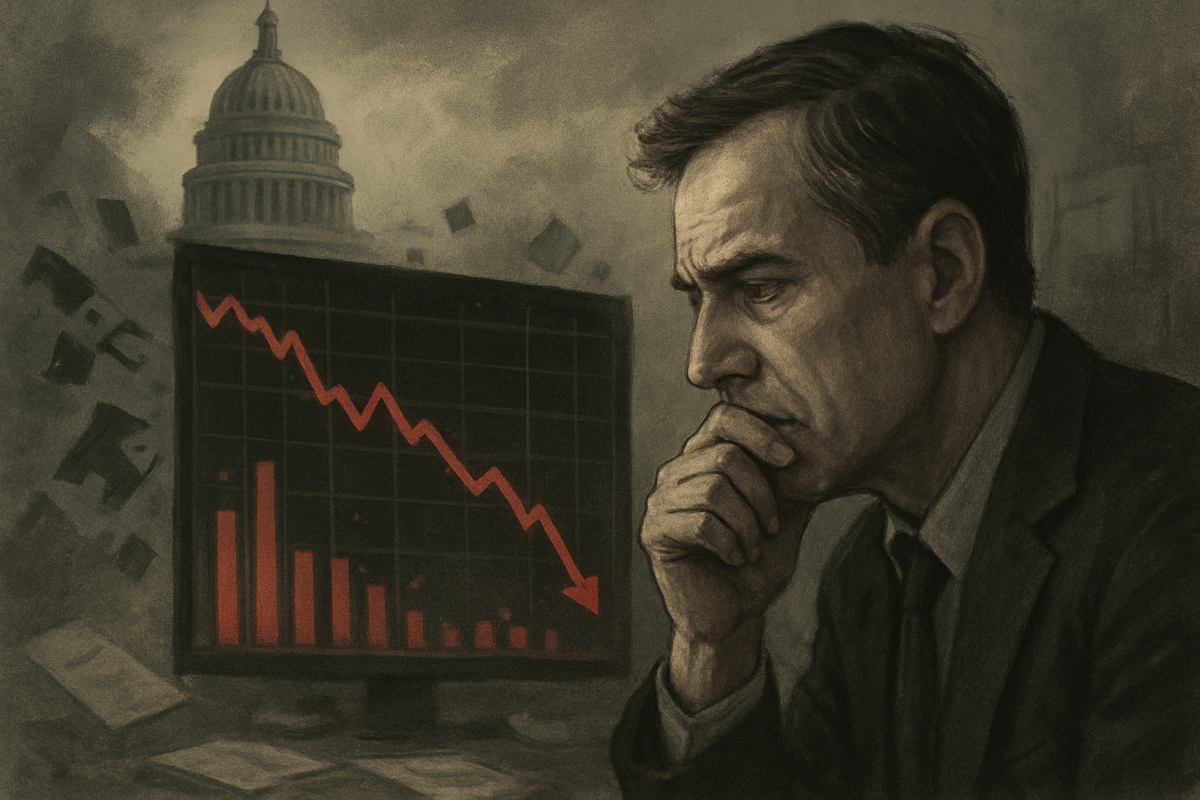
As of November 7, 2025, financial markets are gripped by a palpable sense of unease, with stocks experiencing significant downturns driven by a confluence of escalating economic angst and the persistent threat of a U.S. government shutdown. Investor sentiment has turned distinctly "risk-off," leading to widespread declines across major indices and raising concerns about the stability of the broader economy. This atmosphere of caution is fueled by deteriorating consumer confidence, a cooling labor market, and growing anxieties surrounding potential asset bubbles, all of which stand to be severely exacerbated should political impasses lead to a funding lapse in Washington.
The current market environment reflects a deep-seated apprehension among investors. Major indices, including the Dow Jones Industrials, S&P 500, and Nasdaq 100, have fallen to fresh two-week lows, with the Nasdaq 100 on track for its worst week since April, when it entered a bear market. This decline is largely attributable to concerns over weakening economic sectors, particularly in technology, where "sky-high" valuations are being reassessed. The looming specter of a government shutdown adds another layer of profound uncertainty, threatening to disrupt essential services, delay critical economic data, and further erode already fragile confidence.
Deep Dive into the Brewing Economic Storm
The economic angst pervading markets on November 7, 2025, stems from several interconnected factors, creating a challenging backdrop against which the threat of a government shutdown looms large. Consumer sentiment has plummeted to a three-year low, reaching levels not seen since the severe inflation of 2022. The University of Michigan's consumer sentiment index for November fell significantly, reflecting broad-based worries about personal finances and future business conditions, with a substantial 71% of respondents anticipating a rise in unemployment over the next year.
The labor market, while showing some pockets of resilience, is broadly cooling. U.S. job openings unexpectedly rose in November, yet other indicators, such as a slight increase in layoffs and fewer people quitting their jobs, suggest a deceleration. October 2025 witnessed the most severe corporate layoffs since 2003, with over 1 million job reductions in the first ten months of the year. This slowdown, combined with stagnant wage growth, paints a picture of increasing worker insecurity. The potential for a government shutdown further complicates this, as the suspension of official jobs reports would leave economists and policymakers "groping around in the dark" about the true state of employment.
Adding to the apprehension are escalating warnings about a potential "AI bubble." Prominent figures like Børge Brende of the World Economic Forum and industry titans such as Warren Buffett and Elon Musk have drawn parallels to the 1999 dot-com bubble, citing extreme valuations for AI companies and concerns about the monetization of AI technology. This has already contributed to a sell-off in AI-related stocks. Globally, the economy is described as "limping" amidst geopolitical challenges and policy fragmentation, with persistent "stickiness" in core inflation remaining a global concern, despite some central banks implementing rate cuts.
The prospect of a government shutdown acts as a potent accelerant to these existing fears. Even the threat of a shutdown immediately heightens uncertainty, leading to increased market volatility and a shift towards safer assets. Historically, markets often experience short-term selling pressure in anticipation of a closure, particularly in sectors reliant on government contracts. While past shutdowns have often seen markets recover once a resolution is reached, the current environment, marked by deep political divisions and an economy already vulnerable to shocks, suggests that any such shutdown could have a more pronounced and lasting impact on equity markets. The critical concern is the potential for a "market data blind spot" due to delayed economic reports, making it harder for investors and policymakers to accurately assess the economy's health.
Companies Navigating the Headwinds: Winners and Losers
The pervasive economic angst and the looming threat of a government shutdown create a bifurcated market, distinguishing between companies and sectors poised for resilience and those facing significant headwinds.
Companies and Sectors Most Likely to Lose:
- Government Contractors: Companies heavily reliant on federal contracts face severe disruptions. A shutdown means halted contract awards, delayed payments, and potential stop-work orders, severely impacting revenue streams and cash flow. Small and mid-sized defense contractors, in particular, are vulnerable due to limited reserves. Larger players like Leidos (NYSE: LDOS) and General Dynamics (NYSE: GD) may have more resilience but would still face operational challenges.
- Travel and Tourism Industry: This sector is highly sensitive. The U.S. Travel Association estimates a shutdown could cost the travel economy $1 billion per week. Disruptions to essential personnel like TSA officers and FAA staff could lead to flight delays and cancellations, impacting airlines such as Delta Air Lines (NYSE: DAL) and United Airlines Holdings (NASDAQ: UAL). Reduced consumer confidence and closures of national parks would also hit hotels like Marriott International (NASDAQ: MAR) and other leisure businesses.
- Consumer Discretionary Sector: With consumer sentiment plummeting, spending on non-essential goods and services is expected to contract. High interest rates, inflation, and a cooling labor market reduce disposable income. Automakers like Tesla (NASDAQ: TSLA), General Motors (NYSE: GM), and Ford Motor Company (NYSE: F), along with non-essential retailers and entertainment venues, would likely see significant demand erosion.
- Technology Sector (High-Growth/AI): While a growth engine, this sector faces valuation reassessments amidst economic slowdown fears. Companies like NVIDIA Corporation (NASDAQ: NVDA) have seen downturns due to concerns over inflated valuations and geopolitical tensions impacting chip sales. The sector has also been hit hard by recent corporate layoffs.
- Commercial Real Estate (Lessors to Government): Lessors to the U.S. General Services Administration (GSA) could face delays in lease payments and approvals, impacting their cash flow and operations.
Companies and Sectors Most Likely to Win (or be more resilient):
- Consumer Staples: These companies provide essential goods (food, household items) that consumers prioritize regardless of economic conditions. Firms like Procter & Gamble (NYSE: PG) or Coca-Cola (NYSE: KO) often see stable demand, making them defensive investments during uncertain times.
- Utilities: Companies providing essential services like electricity and water, such as NextEra Energy (NYSE: NEE) or Duke Energy (NYSE: DUK), benefit from stable demand and often regulated pricing, offering defensive appeal.
- Healthcare: Healthcare services and products are generally considered essential, making demand less elastic to economic fluctuations. Pharmaceutical companies, hospitals, and medical device manufacturers like Johnson & Johnson (NYSE: JNJ) tend to be more resilient.
- Companies with Strong Balance Sheets and Diversified Revenue Streams: Businesses with ample cash reserves, low debt, and a broad customer base are better equipped to weather payment delays, reduced demand, and increased operational costs, potentially gaining market share as weaker competitors struggle.
Wider Significance and Historical Context
The brewing economic angst and the persistent threat of a government shutdown carry wider significance, impacting broader industry trends, creating ripple effects, and highlighting persistent regulatory and policy challenges.
This period of uncertainty fits into broader trends of decelerating global growth, persistent inflationary pressures, and a re-evaluation of high-growth tech valuations. The potential for a shutdown exacerbates these trends by injecting political instability into an already fragile economic picture. Ripple effects would be extensive: consumer spending would likely slow further as federal workers face potential furloughs or unpaid work, impacting retailers and the broader service industry. Small businesses, particularly those reliant on federal contracts or local government activity, would face severe disruptions in cash flow and access to resources.
Regulatory and policy implications are profound. A shutdown would freeze new regulations, delay federal permits, and halt loan applications, impeding business operations across various sectors. Crucially, the suspension of government economic data collection would create an "economic blind spot," making it challenging for the Federal Reserve to make informed monetary policy decisions and for businesses to plan effectively. This lack of data can lead to increased market volatility as investors operate with incomplete information.
Historically, government shutdowns have varied in duration and economic impact. While financial markets have often shown initial volatility but tended to recover relatively quickly after resolutions, there are growing concerns that the cumulative effect of repeated impasses erosions international confidence in U.S. governance. Past prolonged shutdowns, like the 35-day event in 2018-2019, resulted in billions of dollars in lost economic output, with a portion of that loss being permanent. Each week of a shutdown can reduce annualized GDP growth by approximately 0.1 to 0.2 percentage points. The current political dynamics, characterized by deep partisan divisions, suggest that any potential shutdown could be protracted and potentially more damaging than previous instances, especially given the existing economic anxieties.
What Comes Next: Navigating Uncertainty
The path forward is fraught with uncertainty, demanding strategic pivots and careful navigation from businesses, investors, and policymakers alike.
In the short term, a potential shutdown would likely lead to further weakening of consumer spending, a continued cooling of the labor market, and significant disruptions to government services. Critical economic data would remain unavailable, complicating the Federal Reserve's ability to assess the economy and potentially delay crucial interest rate decisions. GDP growth for Q4 2025 could see a notable reduction, with some economic activity permanently lost. Market volatility would remain elevated, with a potential "K-shaped economy" emerging where high-income households fare better than lower-income consumers hit by missed paychecks and benefit cuts.
In the long term, a prolonged period of economic angst and political dysfunction risks eroding consumer and investor confidence, potentially dampening sustained economic growth. There will be increased pressure for policymakers to develop robust contingency plans for data dissemination and essential services during future impasses. Businesses may increasingly rely on private data sources and advanced analytics to navigate future "data blackouts." Supply chains could face ongoing disruptions due to regulatory delays, leading to increased costs and inventory backlogs.
Strategic pivots are essential. Businesses heavily reliant on government contracts must prioritize diversifying revenue streams and building robust cash reserves. All companies should enhance operational agility, planning for potential delays in federal permits and approvals. Investors should adopt a cautious stance, emphasizing risk management and considering a shift towards defensive assets like healthcare and consumer staples, as well as safe havens such as gold and cash. Diversification and long-term investment strategies, like dollar-cost averaging into low-cost index funds, are advisable to mitigate short-term volatility. Policymakers, facing intense public pressure, will be compelled to find a resolution and implement reforms to prevent future shutdowns.
Market challenges include continued volatility, data uncertainty, and sectoral disparities. However, opportunities may emerge in defensive sectors, and for companies offering data analytics and AI solutions to fill information gaps. Some experts also view significant market pullbacks during these periods as potential "buying opportunities" for long-term investors once a resolution appears on the horizon.
Comprehensive Market Wrap-Up
The confluence of brewing economic angst and the ever-present threat of a government shutdown presents a formidable challenge to the U.S. financial markets as of November 7, 2025. The detailed analysis reveals a landscape where consumer confidence is at multi-year lows, the labor market is decelerating, and concerns over asset valuations, particularly in the AI sector, are escalating. The prospect of a government funding lapse acts as a critical exacerbating factor, threatening to amplify these anxieties by disrupting essential services, delaying vital economic data, and injecting further political instability into an already fragile environment.
Moving forward, the market remains highly susceptible to shifts in political rhetoric and any concrete developments regarding a potential shutdown. The immediate impact of such an event would likely be felt most acutely by government contractors, the travel and tourism industry, and the consumer discretionary sector, which are all highly sensitive to government operations and consumer spending patterns. Conversely, defensive sectors such as consumer staples, utilities, and healthcare are expected to demonstrate greater resilience, serving as potential havens for investors seeking stability.
The lasting impact of this period of heightened uncertainty, particularly if a shutdown were to materialize and be prolonged, could include a permanent loss of economic output, a further erosion of consumer and business confidence, and a re-evaluation of U.S. governance stability on the international stage. The absence of reliable government economic data, in particular, poses a significant risk, potentially forcing the Federal Reserve to make monetary policy decisions with incomplete information and increasing market volatility.
Investors in the coming months should meticulously monitor legislative developments in Washington, D.C., for any signs of progress or further entrenchment regarding budget negotiations. Beyond political headlines, close attention should be paid to consumer sentiment indicators, labor market reports (when available), and corporate earnings, especially from companies with significant government exposure or those in cyclical sectors. Maintaining a diversified portfolio, emphasizing companies with strong balance sheets, and considering defensive allocations will be crucial for navigating this period of elevated risk. Agility and a long-term perspective will be key to weathering the current storm and identifying potential opportunities that may emerge from the volatility.
This content is intended for informational purposes only and is not financial advice







